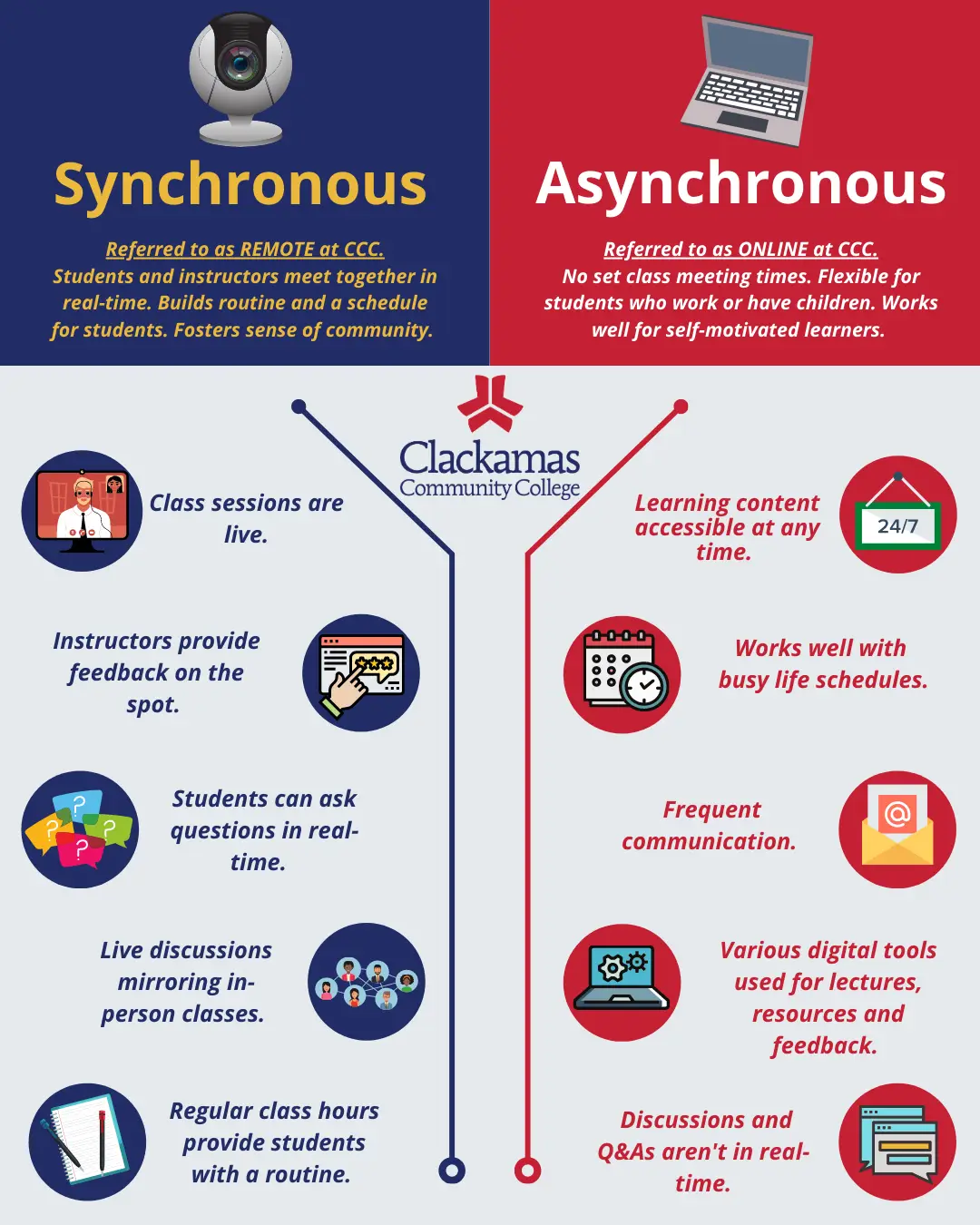Synchronous vs. Asynchronous Learning in Online Education

Synchronous and Asynchronous Defined
Synchronous and asynchronous learning environments have some key differences.
Let’s take a quick look at the definitions of each word first. Synchronous is defined as “occurring at the same time; coinciding in time; contemporaneous; simultaneous.” Asynchronous is defined as “not occurring at the same time.”
So, you’re probably thinking the following: “What does this mean when it comes to online classes?”
Synchronous vs. Asynchronous Online Classes
Synchronous online classes require both the students and the instructor to be online at the same time. They meet at a set class time and day for either a lecture, discussion, presentation or other events.
On the other hand, asynchronous online classes don’t require students and the instructor to be online at the same time. Students can access lectures and resources at any time.
How Clackamas Community College Labels Online Classes
Online (asynchronous): These classes are fully online the entire term with no set class meeting days/times. There are no days/times listed in the course schedule, thus they have asynchronous instruction throughout the entirety of the term.
 Remote (synchronous): These classes are fully online the entire term but they also have specific class meeting days/times. Classes meet each week on specific days/times and will involve synchronous instruction throughout the entirety of the term. The days/times are listed in the class schedule.
Remote (synchronous): These classes are fully online the entire term but they also have specific class meeting days/times. Classes meet each week on specific days/times and will involve synchronous instruction throughout the entirety of the term. The days/times are listed in the class schedule.

Hybrid: These classes are a combination of Online and Remote. Classes have specific meeting days/times during the term — but do not require synchronous instruction every week. In some cases, Hybrid classes will mostly meet online but will also have some face-to-face classes, such as labs. Days/times are listed in the class schedule.

Synchronous vs. Asynchronous: What’s Best for You?
Each class type has advantages. For example, if you’re a student who has to work — or you have a family — asynchronous (Online) courses can help you fulfill most course requirements on your own time. If you like to connect with your peers and instructors face-to-face, synchronous (Remote) courses are a great option.
Here's a quick overview of the differences between the courses:
Synchronous vs. Asynchronous Infographic Description
SYNCHRONOUS COLUMN:
Referred to as REMOTE at CCC.
Students and instructors meet together in real-time. Builds routine and a schedule for students. Fosters sense of community.
- Webinar icon: Class sessions are live.
- Hand rating content icon: Instructors provide feedback on the spot.
- Question marks icon: Instructors provide feedback on the spot.
- Network of people icon: Live discussions mirroring in-person classes.
- Paper and pen icon: Regular class hours provide students with a routine.
ASYNCHRONOUS COLUMN:
Referred to as ONLINE at CCC.
No set class meeting times. Flexible for students who work or have children. Works well for self-motivated learners.
- 24/7 sign icon: Learning content accessible at any time.
- Calendar icon: Works well with busy life schedules.
- Email icon: Frequent communication.
- Laptop with gears on screen icon: Various digital tools used for lectures, resources and feedback.
- Digital dialogue icon: Discussion and Q&As aren't in real-time.
Moving Forward with Online Learning
Now that you know the difference between asynchronous (Online) and synchronous (Remote) classes, start thinking about what might fit your needs best. Once you’ve decided, your next step is to look for classes in the class schedule. Search CCC’s online classes below and make sure to double-check the class type before registering. Hint: See if the class has listed dates/times or not.
If you have questions about online learning, and what classes to take, don’t hesitate to reach out to an adviser.
